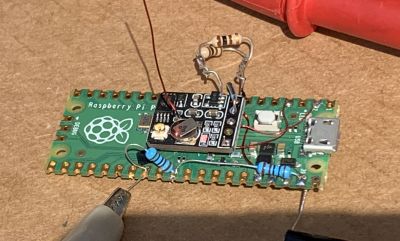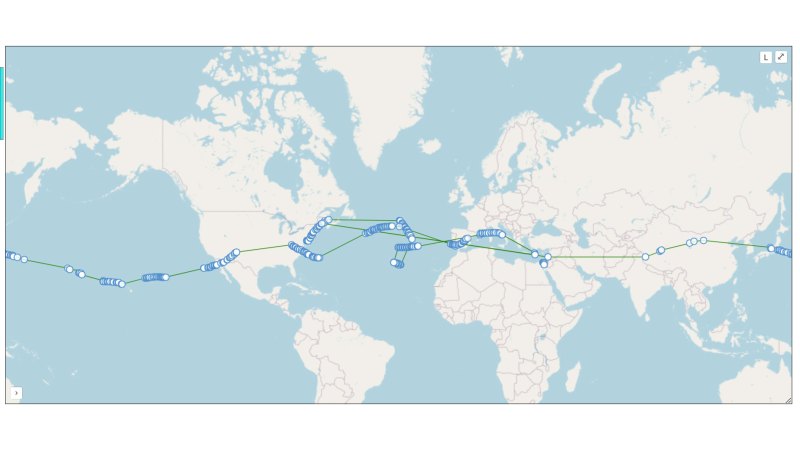They say that if you love something, you should set it free. That doesn’t mean that you should spend any more on it than you have to though, which is why [EngineerGuy314] put together this Raspberry Pi Pico high-altitude balloon tracker that should only set you back about $12 to build.
This simplified package turns a Pico into a tracking beacon — connect a cheap GPS module and solar panel, and the system will transmit the GPS location, system temperature, and other telemetry on the 20-meter band using the Weak Signal Propagation Reporter (WSPR) protocol. Do it right, and you can track your balloon as it goes around the world.

The project is based in part on the work of [Roman Piksayin] in his Pico-WSPR-TX package (which we covered before), which uses the Pico’s outputs to create the transmitted signal directly without needing an external radio. [EngineerGuy314] took this a step further by slowing down the Pico and doing some clever stuff to make it run a bit more reliably directly from the solar panel.
The system can be a bit fussy about power when starting up: if the voltage from the solar panel ramps up too slowly, the Pico can crash when it and the GPS chip both start when the sun rises. So, a voltage divider ties into the run pin of the Pico to keep it from booting until the voltage is high enough, and a single transistor stops the GPS from starting up until the Pico signals it to go.
It’s a neat hack that seems to work well: [EngineerGuy314] has launched three prototypes so far, the last of which traveled over 62,000 kilometers/ 38,000 miles.
















The Github link seems to be broken.
Very cool project!
btw: The URL under “Raspberry Pi Pico high-altitude balloon tracker” is missing an “r”.
Working link: https://github.com/EngineerGuy314/pico-WSPRer
Thanks! Fixed.
It may have turned into an i and tried to hide out in the article title where it got turned into an I.
Or is “ALTITIUDE” a British variant like aluminium? :-)
Correct link to the github repo:
https://github.com/EngineerGuy314/pico-WSPRer
I really enjoy seeing projects that are deployed “into the wild” and have to work autonomously. The most off-grid projects I have done are weather stations supplied by solar panels and sending that via Wi-Fi, that I keep near my apartment windows.
Fine until it gets mistaken for a Chinese spy balloon and causes an international incident
That only happened with that one amateur balloon. Or maybe two.
“..local regulations..” 🤔
It’s a couple I/O pins of a Pico connected directly to the antenna. I very much doubt it reaches a power level that one need be concerned.
This is what modes like WSPR are for. Communication via really really low power.
Unless you are talking about the balloon itself and flight regulations. I’d be more worried about that. But enough people do similar things that I’m sure it’s ok.
The rules for balloons are insane.
As long as it’s either under a specific weight, or under a specific volume of gas it’s very likely to be otherwise unregulated. And a pico isn’t going to challenge those numbers.
Check the local regulations for your rules, but chances are it’s pretty open.
The real question would be will it cause damage to an airplane if it was sucked into the jet engine at high temperatures. They are designed to handle birds which are mostly water and some small low density bones. But looking at the above board I would probably have removed the USB connector, the less metal the better for the engine.
Back in the chicken room days at MACDAC in long beach ca, they cannon fired a mostly frozen mil spec duck unto the intake if the engine to make sure the engine series would survive. A couple pound balloon and circuit board might cause problems it the system were injested at 38,000 ft and it wasnt visible on aircraft radar
The engines have to be certified to be able to eat a surprisingly large amount of large-diameter hail; a Pico isn’t gonna strain them at all.
And, the balloon-specific-weight limits are derived from windshield-strain requirements, so a Pico is fine there as well.
It doesn’t take a lot to risk an airplane, but the balloon regs are quite conservative, even given what the aircraft are certified to handle.
The question is around for 50 to 70 years alread, I believe. Some laymen even wonder why probes can’t “steer” to avoid an incoming obstacle. *sigh*
Long story short, party balloons and the payload they can carry aren’t a threat to airplanes.
The weather probes being daily sent into the sky aren’t much different to the Pico here.
Some probes do have a radar reflector, though. It’s not a requirement in all countries, though (optional).
It’s good enough if the air control knows when and where a balloon is being sent out.
I have no complaints for this project.
Filtering is being mentioned on project site, the use of an one-transistor amplifier..
It’s essentially using same basic principles to building little spy bugs, cw beacons, foxoring beacons and such.
I think that’s interesting, because it trains other skill sets that people may have.
And that’s the very heart of amateur radio, I think. It encapsulates other interests/hobbies and brings people of different origin together.
Also, check out the neat package available at QRP-LABS. It’s the UB4 tracker. There’s lots of links to supporting information for PICO balloons.
A licensed friend releases similarly small packages from southern California that use APRS, and has enough geo-fence logic to turn off over the UK, Yemen, and North Korea. I’ve heard WSPR has similar restrictions. Some quick grepping suggests this code doesn’t attempt geo-fencing.
Well at least you didn’t see the part of the code that takes high-res pictures, monitors cell communication, and phones home through an NSA satellite. Phew! I was worried there.